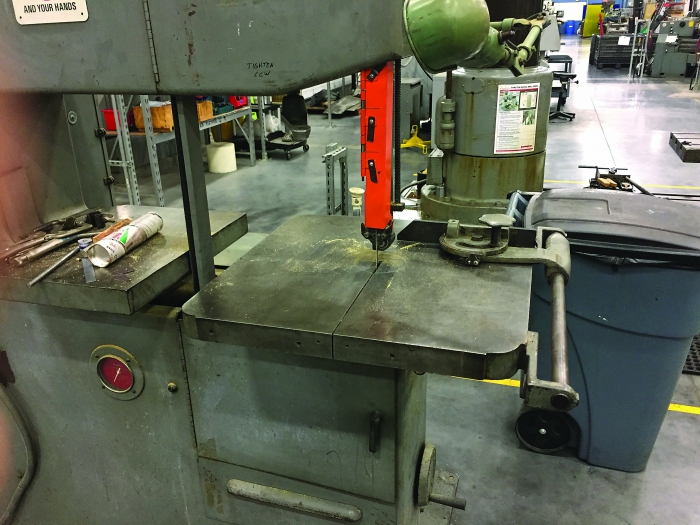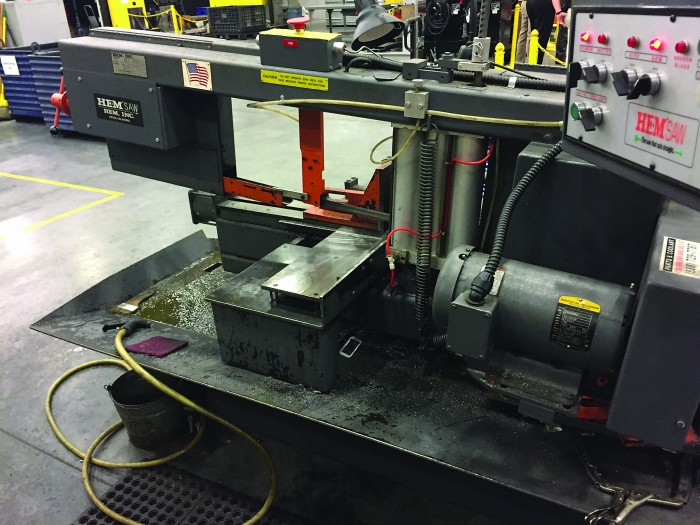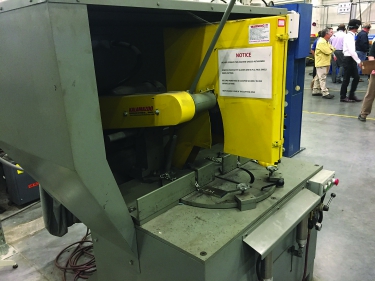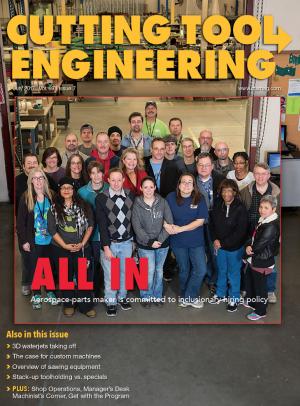Extracting computer-generated shapes from CNC machines with high-pressure water and high-energy lasers can be appealing, making it is easy to forget about more-traditional cutting methods such as sawing.
Sawing is one of the most common manufacturing processes in a machine shop. It is versatile, simple and reliable. Nonetheless, many of the young engineers and machinists I meet are quite familiar with lasers and abrasive waterjets but have no knowledge of sawing. Sawing may be less interesting than some machining technologies, but it is still a vital machining operation.
Sawing equipment falls into four basic categories: bandsaws, hacksaws, circular saws and abrasive saws. Each type has its place in manufacturing and, when applied correctly, is efficient and effective.
The Omnipresent Bandsaw
Toolmakers and machinists are probably most familiar with bandsaws, which are found in machining environments ranging from one-off and low-volume tool shops to high-production automotive manufacturers. They are the most-versatile and cost-effective style of saw. And, compared to other types of saws, they can cut a broader range of material types and feature sizes. They provide a wider range of cutting speeds and feed rates and are also reasonably accurate and repeatable.

This vertical saw has several attachments to assist cutting, such as the miter attachment shown on the saw table. All images courtesy of C. Tate.
Bandsaws come in two styles: horizontal and vertical. Construction is similar for both styles, but the blade orientation provides distinct advantages, depending on the application.
A horizontal bandsaw presents the saw blade to the workpiece in a plane that is parallel to the floor. Because of the approach angle of the blade, a horizontal saw is well-suited for cutting long materials, such as bar, tube, pipe and structural shapes, to the desired lengths.
In contrast, a vertical bandsaw presents the blade to the workpiece in a plane that is perpendicular to the floor. It is best-suited for cutting shapes from flat materials, like plates and sheets.
The traditional vertical saw is manually operated. Therefore, it is well-suited for cutting shapes out of plates. While not impossible, it is improbable that an automatic saw would be used to rough components before machining. Manual saws are more suitable for this activity in toolrooms because of low part volumes. Other methods, possibly waterjetting, would be used for similar tasks in a production setting.

At Mitsubishi’s valve shop, this horizontal bandsaw is used more than the shop’s two other saws.
More-complex versions, which are often automated, usually with a CNC, are called “plate saws.” These saws have large tables that are capable of accommodating entire plates from which smaller pieces are cut. Many metal suppliers employ plate saws to cut square, rectangular and odd-shaped pieces of tool steel. In addition, some manufacturers use plate saws to cut blanks that are then machined.
Aerospace manufacturers often use plate saws in applications where thermal cutting, such as plasma arc or laser, can create heat-affected zones that compromise the mechanical properties of the material.
Vertical saws can cut bars, shapes and tubes. However, they are not typically configured with the same type of clamping mechanisms as horizontal saws, which have clamps that work much like a vise. The workpiece is clamped between one stationary jaw and one movable jaw. Horizontal saws hold the material stationary and pass the blade through the material during the cut, whereas vertical saws must move the material into the blade. Because horizontal saws hold the material stationary, they are better-suited for cutting long, thin pieces of bundled material like pipes and bar stock. Conversely, a vertical design economically provides the capacity to saw large plates; a horizontal capable of sawing large plates would not be economical to build.
Kin to the horizontal bandsaw is the power hacksaw. Bandsaws have driven the power hacksaw to the brink of extinction; finding a new hacksaw is difficult. Hacksaws are simple machines. They have the same configuration as bandsaws but incorporate a reciprocating motion to make the cut. They are effective but slow.
Circular Reasoning
Circular saws, also known as cold saws, are excellent choices for achieving accurate cuts. Stiff blades and rigid ways stabilize the saw, allowing exceptional miter joints and very square ends.
Cold saws owe their accuracy to their construction, which is similar to a milling machine, where a carriage with a motor and blade ride on a set of ways mounted to a sturdy column. Cold saws are an excellent choice for shops that must produce very accurate geometries for welding fabrication or where the cut end must have a fine finish.
Manually operated cold saws are very compact. Their size makes them ideal for small tool shops or cramped work areas. Cold saws are also suitable for production work. The disadvantage of a cold saw, compared to a bandsaw, is its limited capacity. Dollar for dollar, the bandsaw can cut much larger material. A cold saw is limited to workpieces that can fit between the edge of the blade and arbor where the blade mounts; bandsaws do not have this limitation.

This large abrasive saw is for roughing large channels, angle iron and similar applications.
High-quality finishes are a result of blades that are constructed of HSS with ground teeth or brazed carbide, which are for cutting nonferrous material. The blades are basically large milling tools. They can be manufactured with many different tooth pitches.
These blades also make a cold saw ideal for difficult-to-cut materials, such as thin-walled tubing and soft, gummy plastics.
Barbaric Blades
No sawing discussion would be complete without covering abrasive cutoff saws. As the name implies, these saws utilize blades made from abrasives, usually aluminum oxide encapsulated in a fiber-reinforced resin.
Compared to the other saws discussed, abrasive saws are barbaric. They are hot, dirty and not highly accurate, but they do have a place in manufacturing.
Abrasive saws are easy to use and require little maintenance. They don’t need coolant and are economical to operate. These saws are often found in places that need to quickly cut something long down to size.
Abrasive saws are also used to remove sprues, gates and slag from forgings and castings. They are often found in shops that fabricate rebar. Abrasive saws and blades are forgiving, which makes them suitable for harsh
environments.
Sawing is a basic machining process, one that is used in manufacturing most metal products. But unlike turning and milling, where new products are constantly released, sawing has seen relatively few innovations. This is evidence that sawing has been, and continues to be, an efficient, robust and reliable process.
Related Glossary Terms
- abrasive
abrasive
Substance used for grinding, honing, lapping, superfinishing and polishing. Examples include garnet, emery, corundum, silicon carbide, cubic boron nitride and diamond in various grit sizes.
- aluminum oxide
aluminum oxide
Aluminum oxide, also known as corundum, is used in grinding wheels. The chemical formula is Al2O3. Aluminum oxide is the base for ceramics, which are used in cutting tools for high-speed machining with light chip removal. Aluminum oxide is widely used as coating material applied to carbide substrates by chemical vapor deposition. Coated carbide inserts with Al2O3 layers withstand high cutting speeds, as well as abrasive and crater wear.
- approach angle
approach angle
Angle between the insert’s side-cutting edge and the line perpendicular to the milling cutter’s axis of rotation. Approach angle, which is also known as cutting edge angle, is used with metric units of measurement. See lead angle.
- arbor
arbor
Shaft used for rotary support in machining applications. In grinding, the spindle for mounting the wheel; in milling and other cutting operations, the shaft for mounting the cutter.
- bandsaw
bandsaw
Machine that utilizes an endless band, normally with serrated teeth, for cutoff or contour sawing. See saw, sawing machine.
- computer numerical control ( CNC)
computer numerical control ( CNC)
Microprocessor-based controller dedicated to a machine tool that permits the creation or modification of parts. Programmed numerical control activates the machine’s servos and spindle drives and controls the various machining operations. See DNC, direct numerical control; NC, numerical control.
- coolant
coolant
Fluid that reduces temperature buildup at the tool/workpiece interface during machining. Normally takes the form of a liquid such as soluble or chemical mixtures (semisynthetic, synthetic) but can be pressurized air or other gas. Because of water’s ability to absorb great quantities of heat, it is widely used as a coolant and vehicle for various cutting compounds, with the water-to-compound ratio varying with the machining task. See cutting fluid; semisynthetic cutting fluid; soluble-oil cutting fluid; synthetic cutting fluid.
- cutoff
cutoff
Step that prepares a slug, blank or other workpiece for machining or other processing by separating it from the original stock. Performed on lathes, chucking machines, automatic screw machines and other turning machines. Also performed on milling machines, machining centers with slitting saws and sawing machines with cold (circular) saws, hacksaws, bandsaws or abrasive cutoff saws. See saw, sawing machine; turning.
- feed
feed
Rate of change of position of the tool as a whole, relative to the workpiece while cutting.
- flat ( screw flat)
flat ( screw flat)
Flat surface machined into the shank of a cutting tool for enhanced holding of the tool.
- gang cutting ( milling)
gang cutting ( milling)
Machining with several cutters mounted on a single arbor, generally for simultaneous cutting.
- high-speed steels ( HSS)
high-speed steels ( HSS)
Available in two major types: tungsten high-speed steels (designated by letter T having tungsten as the principal alloying element) and molybdenum high-speed steels (designated by letter M having molybdenum as the principal alloying element). The type T high-speed steels containing cobalt have higher wear resistance and greater red (hot) hardness, withstanding cutting temperature up to 1,100º F (590º C). The type T steels are used to fabricate metalcutting tools (milling cutters, drills, reamers and taps), woodworking tools, various types of punches and dies, ball and roller bearings. The type M steels are used for cutting tools and various types of dies.
- mechanical properties
mechanical properties
Properties of a material that reveal its elastic and inelastic behavior when force is applied, thereby indicating its suitability for mechanical applications; for example, modulus of elasticity, tensile strength, elongation, hardness and fatigue limit.
- milling
milling
Machining operation in which metal or other material is removed by applying power to a rotating cutter. In vertical milling, the cutting tool is mounted vertically on the spindle. In horizontal milling, the cutting tool is mounted horizontally, either directly on the spindle or on an arbor. Horizontal milling is further broken down into conventional milling, where the cutter rotates opposite the direction of feed, or “up” into the workpiece; and climb milling, where the cutter rotates in the direction of feed, or “down” into the workpiece. Milling operations include plane or surface milling, endmilling, facemilling, angle milling, form milling and profiling.
- milling machine ( mill)
milling machine ( mill)
Runs endmills and arbor-mounted milling cutters. Features include a head with a spindle that drives the cutters; a column, knee and table that provide motion in the three Cartesian axes; and a base that supports the components and houses the cutting-fluid pump and reservoir. The work is mounted on the table and fed into the rotating cutter or endmill to accomplish the milling steps; vertical milling machines also feed endmills into the work by means of a spindle-mounted quill. Models range from small manual machines to big bed-type and duplex mills. All take one of three basic forms: vertical, horizontal or convertible horizontal/vertical. Vertical machines may be knee-type (the table is mounted on a knee that can be elevated) or bed-type (the table is securely supported and only moves horizontally). In general, horizontal machines are bigger and more powerful, while vertical machines are lighter but more versatile and easier to set up and operate.
- parallel
parallel
Strip or block of precision-ground stock used to elevate a workpiece, while keeping it parallel to the worktable, to prevent cutter/table contact.
- power hacksaw
power hacksaw
Machine fitted with serrated blade held taut in a reciprocating frame that cuts in one direction, either on the forward or return stroke. See saw, sawing machine.
- sawing
sawing
Machining operation in which a powered machine, usually equipped with a blade having milled or ground teeth, is used to part material (cutoff) or give it a new shape (contour bandsawing, band machining). Four basic types of sawing operations are: hacksawing (power or manual operation in which the blade moves back and forth through the work, cutting on one of the strokes); cold or circular sawing (a rotating, circular, toothed blade parts the material much as a workshop table saw or radial-arm saw cuts wood); bandsawing (a flexible, toothed blade rides on wheels under tension and is guided through the work); and abrasive sawing (abrasive points attached to a fiber or metal backing part stock, could be considered a grinding operation).
- sawing machine ( saw)
sawing machine ( saw)
Machine designed to use a serrated-tooth blade to cut metal or other material. Comes in a wide variety of styles but takes one of four basic forms: hacksaw (a simple, rugged machine that uses a reciprocating motion to part metal or other material); cold or circular saw (powers a circular blade that cuts structural materials); bandsaw (runs an endless band; the two basic types are cutoff and contour band machines, which cut intricate contours and shapes); and abrasive cutoff saw (similar in appearance to the cold saw, but uses an abrasive disc that rotates at high speeds rather than a blade with serrated teeth).
- turning
turning
Workpiece is held in a chuck, mounted on a face plate or secured between centers and rotated while a cutting tool, normally a single-point tool, is fed into it along its periphery or across its end or face. Takes the form of straight turning (cutting along the periphery of the workpiece); taper turning (creating a taper); step turning (turning different-size diameters on the same work); chamfering (beveling an edge or shoulder); facing (cutting on an end); turning threads (usually external but can be internal); roughing (high-volume metal removal); and finishing (final light cuts). Performed on lathes, turning centers, chucking machines, automatic screw machines and similar machines.


